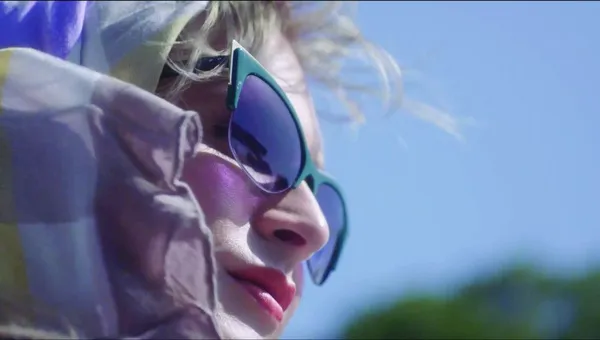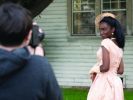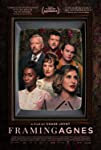Eye For Film >> Movies >> Framing Agnes (2022) Film Review
Framing Agnes
Reviewed by: Jennie Kermode

Early in this film, there’s a shot of Agnes (played by Zackary Drucker) putting on make-up. It’s a shot which will make every trans viewer sigh internally – or perhaps even aloud – because it’s such a cliché, but in this case that’s part of the point. Part documentary, part fiction, part making-of, this deconstructed film is an exploration of the way that trans people are framed in medicine, in society and on film. The Agnes of its title is a legendary (though otherwise) anonymous) young woman who gained access to medical transition at UCLA in the late 1940s by pretending to be intersex – it is believed that she had already induced some physiological changes in herself by using oestrogen pills. After her transition was complete, she returned to the institute to tell the doctors there what she had done, requiring several scientific papers to be rewritten. The film muses on how she got away with it.
Drucker embodies what many doctors treating trans women looked for at that time – what some still do today. The perfect image of a certain type of femininity: young, white, slim, blond, advantaged in terms of her class and education. Her records were found in the archives of Dr Harold Garfinkel, and it’s clear that he thought of her as the ideal patient – but whilst the other participants here clearly respect her and are glad that she, at least, managed to outwit the doctors and live a happy life, they question whether or not we should really think of her as exceptional.

Alongside Agnes’ patients were those of other patients who lacked equivalent opportunity. Reframing the medical interviews as a television talk show, in the style popular at the time, the film explores how differently each of them was seen within the conceptual frameworks available at the time. There’s Barbara, who might almost have succeeded like Agnes but didn’t know what she should and shouldn’t say, referring to her past work as a female impersonator and failing to get through to the doctor what made those OTT stage performances – her only means of earning a living in a world where opportunities were few enough for cis women, let alone trans ones – differed from her day to day life. For the others, it was harder still.
Georgia never stood a chance – her dark skin saw to that. Despite her elegant clothes, she just couldn’t satisfy a white man’s idea of what a woman should be. We see her describe how, going out to meet her husband, she was arrested and locked up by police convinced she must be soliciting. African American people were, and are, subject to a different kind of framing. Agnes might have hoped to move to the suburbs, marry, and blend in. For Georgia, simply moving through the world was a risk, and her situation enables the filmmakers to challenge the perception that liberty always lies in openness, arguing that for some people, there must be a right to invisibility (one might call it a right to privacy), the moral issues surrounding truth and lies blurring when some truths are hard for the uneducated to understand and some lies are necessary for survival.
Though, as a rule, we hear a lot less about trans men in that period, some of their stories are explored here, including the rather uplifting tale of a teenager whose mother supported him and who seemed to have fun teasing the doctor. There’s also a case of a person who might today be seen as non-binary, definitely masculine but not wholly identified as a man. Some viewers may be surprised to learn that this was actually easier, in some ways, at the time, as the doctors at UCLA dealt with trans, intersex and gay, lesbian or bisexual people as well as those questioning their identities, not seeing much difference between them.
There’s a discussion of categories and how, whilst they are helpful in some ways, they also speak to the scientific habit of trying to squeeze complex human experiences into neat and discreet little boxes. Those boxes also end up shaping behaviour, as people try to reshape themselves, at least publicly, to fit into them better and thereby make their lives easier. Footage of trans pioneer Christine Jorgensen is shown as participants comment on how fortunate it was that she just happened to be dressed fabulously and perfectly prepared to meet the press when her story happened to be leaked. Some people are able to control their own framing, at least for a little while.
There’s an acutely self-conscious aspect to this film, which works hard to be reflexive in its analysis, its creators aware that they, too, have biases. For such a studiously artificial work, however, it is profoundly moving. Screening as part of the 2022 Fragments Festival in London, it’s a fascinating study not only of the treatment of trans people in a specific historical context but of gender, race and the social control of meaning more widely.
Reviewed on: 30 Sep 2022
















